On Aug. 6, 1945, during World War II, the United States dropped an atomic bomb on Hiroshima, Japan. About 140,000 people were killed or died within months when the American B-29 “Enola Gay” bombed Hiroshima on Aug. 6, 1945. Three days later, about 80,000 people died after the United States also bombed Nagasaki. Japan surrendered on Aug. 15, ending World War II. To this day, the bombings remain the only time nuclear weapons have been unleashed.
The United States decided to drop the bombs because Washington believed it would hasten the end of the war and avert the need to wage prolonged and bloody land battles on Japan’s main island. That concern was heightened by Japan’s desperate efforts to control outlying islands such as Iwo Jima and Okinawa as the Allies closed in.
The Hiroshima explosion, recorded at 8:15am, August 6, 1945, is seen on the remains of a wristwatch found in the ruins in this 1945 United Nations photo. The shadow of the small hand on the eight was burned in from the blast, making it appear to be the big hand. (AP Photo/United Nations)
The B-29 superfortress Enola Gay lands at its Tinian base after its atomic bombing mission over Hiroshima on Aug. 6, 1945. (AP Photo)
This is a photograph released by the U.S. government in 1960 that shows the Little Boy atom bomb, the type detonated over Hiroshima on Aug. 6, 1945. The bomb was 29 inches in diameter, 126 inches long and weighed 9,700 pounds with a yield equivalent to 20,000 tons of TNT explosive. (AP Photo)
In this undated handout picture from the U.S. Air Force, the ground crew of the B-29 "Enola Gay" which bombed Hiroshima, Japan on Aug. 6, 1945 with the "Little Boy" nuclear bomb, stands with pilot Col. Paul W. Tibbets, center, in the Marianas Islands. It was the first use of nuclear weapons in warfare. (AP Photo/U.S. Air Force)
Smoke rises 20,000 feet above Hiroshima on Aug. 6, 1945 after the first atomic bomb was dropped during warfare. (AP Photo)
This picture made from the town of Yoshiura on the other side of the mountain north of Hiroshima, Japan, shows the smoke rising from the explosion of the atomic bomb at Hiroshima, Aug. 6, 1945. It was picked up from an Australian engineer at Kure, Japan. Note the radiation spots on the negative caused by the explosion of the A-bomb, almost ruining the film. (AP Photo)
Survivors of the first atomic bomb ever used in warfare are seen as they await emergency medical treatment, on August 6, 1945, in Hiroshima, Japan. The explosion instantly killed more than 60,000 people, with ten of thousands others dying later from effects of the radioactive fallout. (AP Photo)
Shortly after the first atomic bomb ever used in warfare was dropped by the United States over the Japanese city of Hiroshima, survivors are seen as they receive emergency treatment by military medics, on Aug. 6, 1945. The explosion instantly killed more than 60,000 people, with ten of thousands others dying later from effects of the radioactive fallout. (AP Photo)
Rubble was all that was left after the explosion of an atomic bomb in Hiroshima, Japan, on Aug. 6, 1945. U.S. President Harry Truman ordered the first use of this nuclear weapon, which contained more power than 20,000 tons of TNT, to hasten Japan's surrender and end World War II. Japan surrendered on Aug. 14, 1945. The atomic bomb was hailed as one of the most destructive forces in history and among the greatest achievements of science. (AP Photo)
A pall of smoke lingers over this scene of destruction in Hiroshima, Japan, on Aug. 7, 1945, a day after the explosion of the atomic bomb. (AP Photo)
U.S. President Harry Truman, left, back from the Potsdam conference, is shown at his White House desk with Secretary of War Henry L. Stimson in Washington, D.C., Aug. 8, 1945. They discuss the atomic bomb that was dropped on Hiroshima, Japan. (AP Photo)
The shell of a building stands amid acres of rubble in this view of the Japanese city of Hiroshima, Aug. 8, 1945. (AP Photo/Mitsugi Kishida)
Survivors of the atomic bomb attack of Nagasaki walk through the destruction as fire rages in the background, Aug. 9, 1945. (AP Photo)
Crew members of 'The Great Artiste', B-29, that dropped the atomic bomb on Nagasaki, gather around Major Charles W. Sweeney, North Quincy, Mass., upon landing at Mather Field near on Nov. 8, 1945. All are members of crew that participated in historic mission. From Left to Right are; Sgt. R. Gallagher, Chicago; S. Sgt. A. M. Spitzer, Bronx, New York, Capt. C.D. Albury, Miami, Fla., Capt. J.F. Van Pelt, Jr., Oak Hill, W. Va.; Lt. F. J. Olivi, Chicago; S. Sgt. E.K. Buckley, Lisbon, Ohio; T. Sgt. A. T. Dehart, Plainview, Tex., and M. Sgt. J.D. Kuharek, Columbus, Neb. (AP Photo)
Nagasaki Type Bomb: This is the type of atomic bomb exploded over Nagasaki, Japan, in World War II, the Atomic Energy Commission and Defense Department said in releasing this photo in Washington, December 6, 1960. The weapon, known as the "Fat Man" type, is 60 inches in diameter and 128 inches long. The second nuclear weapon to be detonated, it weighed about 10,000 pounds and had a yield equivalent to approximately 20,000 tons of high explosive. (AP Photo)
A giant column of smoke rises more than 60,000 feet into the air, after the second atomic bomb ever used in warfare explodes over the Japanese port town of Nagasaki, on August 9, 1945. Dropped by the U.S. Army Air Forces B-29 plane "Bockscar," the bomb killed more than 70,000 people instantly, with ten thousands dying later from effects of the radioactive fallout. (AP Photo)
A massive column of billowing smoke, thousands of feet high, mushrooms over the city of Nagasaki, Japan, after an atomic bomb was dropped by the United States on Aug. 9, 1945. A B-29 plane delivered the blast killing approximately 70,000 people, with thousands dying later of radiation effects. The attack came three days after the U.S. dropped the world's first atomic bomb on the Japanese city of Hiroshima. The attacks brought about Japan's unconditional surrender, and the war ended when the papers ofsurrender were accepted aboard the U.S. battleship Missouri on Sept. 2, 1945. (AP Photo/U.S.Signal Corps)
An unidentified young boy carries his burned brother on his back Aug. 10, 1945 in Nagasaki, Japan. This photographs was not released to the public by the Japanese military but was disseminated to the world press by the United Nations after the war. (AP Photo/United Nations, Yosuke Yamahata)
Arrow marks the spot where the A-bomb struck at Nagasaki, Japan, August 10, 1945. Much of the bombed area is still desolate, the trees on the hills in the background remained charred and dwarfed from the blast and little reconstruction, except of wooden shacks as homes, has taken place. (AP Photo)
Japanese workers carry away debris in a devastated area of Nagasaki, an industrial city on southwest Kyushu, after the August 9, atomic bombing, . Smokestacks and a lone building stand in background of photo, first ground view of atomic bomb damage in Nagasaki and obtained by the Army from files of Domei, official Japanese news agency. (AP Photo)
A mother and child struggle to go on living, August 10, 1945, a day after the atomic bomb was dropped over Nagasaki, Japan. (AP Photo/United Nations)
A few steel and concrete buildings and bridges are still intact in Hiroshima after the Japanese city was hit by an atomic bomb by the U.S., during World War II Sept. 5, 1945. (AP Photo/Max Desfor)
About one month after the dropping of the first atomic bomb on Aug. 6, 1945, an allied correspondent examines the landscape of destruction at Hiroshima, Japan. (AP Photo)
A victim of the first atomic bomb ever used in warfare is seen in September 1945, at the Ujina Branch of the First Army Hospital in Hiroshima. The thermic rays emitted by the explosion burned the pattern of this woman's kimono upon her back. (AP Photo)
All but a few scattered structures in this section of Hiroshima, Japan, have virtually disappeared in this aerial view after the August 6 atomic bomb was dropped on the city. This is the first original aerial view of the damage done by the nuclear bomb, released Sept. 1, 1945. (AP Photo/US Air Force)
The area around the Sangyo-Shorei-Kan (Trade Promotion Hall) area of Hiroshima is laid waste, after an atomic bomb exploded within 100 meters of here in 1945. (AP Photo)
An allied correspondent stands in a sea of rubble before the shell of a building that once was a movie theater in Hiroshima Sept. 8, 1945, a month after the first atomic bomb ever used in warfare was dropped by the U.S. to hasten Japan's surrender. (AP Photo/Stanley Troutman)
The atomic bomb attack on the Japanese city of Hiroshima, left this mass of twisted steel and this gutted building standing in acres of desolation, Sept. 8, 1945. (AP Photo)
Only a handful of buildings remain standing amid the wasteland of Hiroshima, Sept. 8, 1945, the Japanese city reduced to rubble following the first atomic bomb to be dropped in warfare. (AP Photo)
Two people walk on a cleared path through the destruction resulting from the Aug. 6 detonation of the first atomic bomb, Sept. 8, 1945. (AP Photo/U.S. Air Force)
A Japanese civilian salvages a piece of what was once a child's tricycle in Nagasaki, Sept. 17, 1945. A nuclear bomb was dropped on the city, Aug. 9, 1945, destroying nearly everything within a four-mile area, and instantly killing thousands of civilians. (AP Photo/ACME/Stanley Troutman)
In this picture provided by Japan's Association of the Photographers of the Atomic (Bomb) Destruction of Hiroshima, a nuclear bomb victim lies in quarantine on the island of Ninoshima in Hiroshima, Japan, 9,000-meter (9,843-yard) from the epicenter on Aug. 7, 1945, one day after the bombing by the United States. It was the first use of nuclear weaopns in warfare. (AP Photo/The Association of the Photographers of the Atomic (Bomb) Destruction of Hiroshima, Yotsugi Kawahara
A tram, top center, is flattened in its rails and its passengers flung dead in a ditch, seen Sept. 1, 1945, following the detonation of the atomic bomb over Nagasaki of Aug. 9. (AP Photo/U.S. Army Signal Corps)
A destroyed streetcar sits on the tracks as people walk and bicycle past at the Kamiyacho intersection in Hiroshima, Japan, some time after the atomic bomb was dropped on the city. (AP Photo/Hiroshima A-Bomb Museum)
In this picture provided by Japan's Association of the Photographers of the Atomic (Bomb) Destruction of Hiroshima, nuclear bomb victims are sheltered at the Hiroshima Second Military Hospital's tent relief center at the banks of the Ota River in Hiroshima, Japan, 1,150-meters (1,258-yards) from the epicenter on Aug. 7, 1945, one day after the world's first nuclear bombing by the United States. (AP Photo/The Association of the Photographers of the Atomic (Bomb) Destruction of Hiroshima, Yotsugi Kawahara, HO)
A view of Hachobori Street in Hiroshima, some time after the atomic bomb was dropped on this Japanese city, date unknown. (AP Photo/ Hiroshima A-Bomb Museum)
The Urakami Catholic Cathedral in Nagasaki, seen Sept. 13, 1945, is laid waste in the aftermath of the detonation of the atom bomb over a month ago over this city. (AP Photo/ACME/Stanley Troutman)
A Japanese soldier sifts through debris looking for some material worth salvaging in Nagasaki, Sept. 13, 1945, a little over a month after an atomic bomb was detonated over the city. (AP Photo/ACME/Stanley Troutman)
A man pushes a loaded bicycle down a cleared path in a flattened area of Nagasaki, Sept. 13, 1945, following the Aug. 9 nuclear attack by an American B-29. (AP Photo/ACME/Stanley Troutman)
Japanese people, seen Sept. 14, 1945, use primitive methods to navigate rubble-strewn streets in a suburb four miles outside of Nagasaki, where a nuclear bomb was detonated over the city. (AP Photo/ACME)
This area of Nagasaki, seen in 1945, was crowded with industrial buildings and small residences. In the background are the remains of the Mitsubishi arms factory and a reinforced concrete school building at the foot of the hills. (AP Photo/U.S. Army)
The city of Nagasaki is shown as a teeming urban area, above, then as a flattened, desolate moonscape following the detonation of an atomic bomb, below. Circles delineate the thousands of feet from ground zero. (AP Photo)
A Japanese family eats rice in the crude shack they built from the wreckage left on the spot where their home once stood in Nagasaki, Sept. 14, 1945. (AP Photo)
These shacks, seen Sept. 14, 1945, were made from scraps of debris from buildings that were leveled in the aftermath of the atomic bomb that was dropped over Nagasaki. (AP Photo)
Bombed out shopkeepers sell goods on the sidewalks in Nagasaki in the Ginza district, a district comparable to New York's Fifth Avenue, Sept. 30, 1945. (AP Photo/ACME)
A sacred Torii Gate stands erect over the completely destroyed area of a Shinto shrine in Nagasaki, in October 1945, after the second atomic bomb ever used in warfare was dropped by the U.S. over the Japanese industrial center. Due to its structure, the blast of the explosion could go around it, therefore leaving the arch intact. The bombing killed more than 70,000 people instantly, with ten thousands dying later from effects of the radioactive fallout. (AP Photo)
Church services continued in the Nagarekawa Protestant Church in 1945 after the atomic bomb destroyed the church in Hiroshima. (AP Photo/Nagarekawa Church)
This young man, a victim of the second atomic bomb ever used in warfare, is seen as he is lying sick on a mat, in Nagasaki, in late 1945. The bombing killed more than 70,000 people instantly, with ten thousands dying later from effects of the radioactive fallout. (AP Photo)
Maj. Thomas Ferebee, left, of Mocksville, N.C., and Capt. Kermit Beahan, right, of Houston, Texas, talk at a hotel in Washington, D.C., on Feb. 6, 1946. Ferebee dropped the atomic bomb over Hiroshima, and Beahan dropped the bomb over Nagasaki. They are summoned to the nation's capital from Roswell Field, N.M., to prepare for the joint Army-Navy atomic bomb testing on target warships at Bikini atoll next May. (AP Photo)
U.S. Navy sailors look through debris in the bomb-devastated city of Nagasaki, March 4, 1946. (AP Photo)
This photo shows the total destruction of the city of Hiroshima, Japan, on April 1, 1946. The atomic bomb known as "Little Boy" was dropped over Hiroshima on Aug. 6, 1945 during World War II from the U.S. AAF Superfortress bomber plane called "Enola Gay." (AP Photo)
Ikimi Kikkawa shows keloid scars following the healing of burns caused by the atomic bomb dropped on Hiroshima at the end of the second World War. She was seen at the Red Cross hospital there, June 5, 1947. (AP Photo)
Akira Yamaguchi shows his heavy scars, June 5, 1947, a result of the healing of burns sustained from the atomic bomb attack of Hiroshima. (AP Photo/U.S. Army)
A survivor of the first atomic bomb ever used in warfare, Jinpe Teravama retains scars after healing of burns from the bomb explosion, Hiroshima, in June 1947. (AP Photo)
Commanding officer and pilot Col. Paul W. Tibbets Jr. waves from the cockpit of his bomber plane at its base in Tinian, on August 6, 1945, shortly before take-off to drop the first atomic bomb over Hiroshima, Japan. The day before Tibbets named the B-29 Superfortress after his mother "Enola Gay." (AP Photo)
Fonte

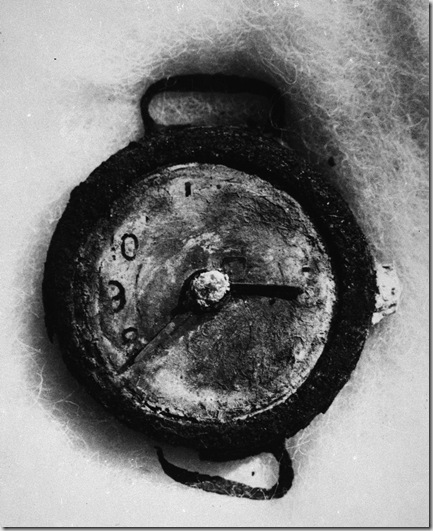

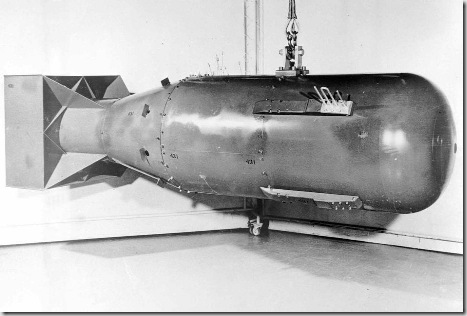

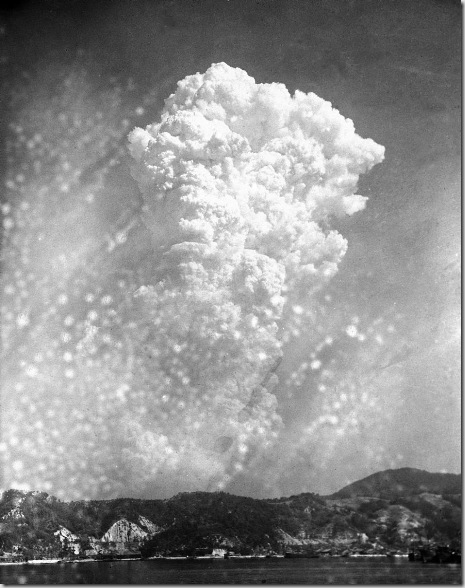




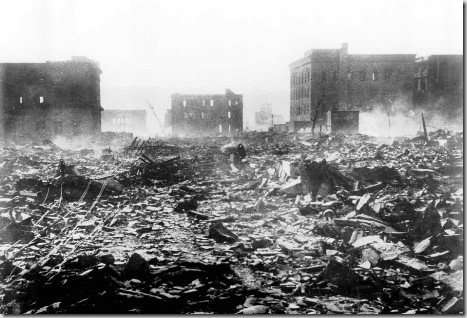






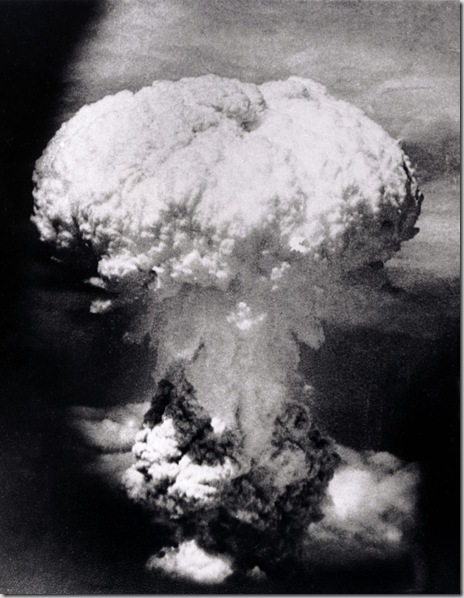
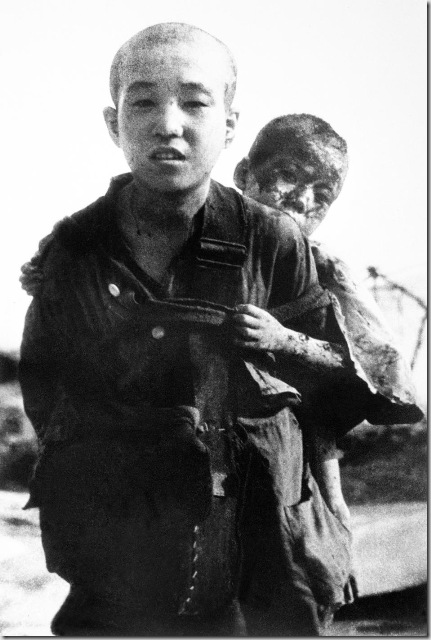


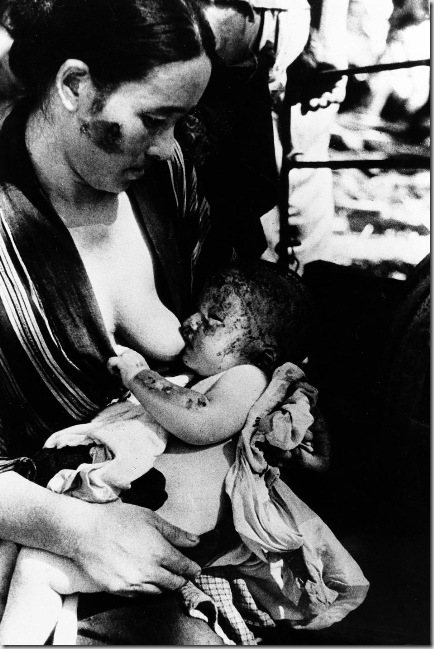

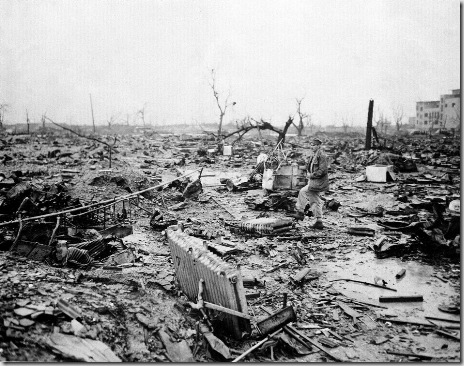








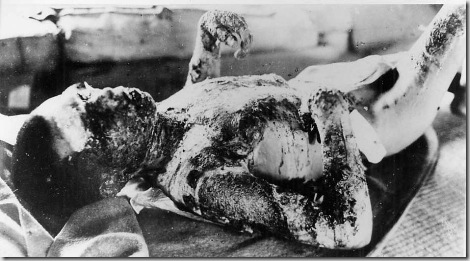
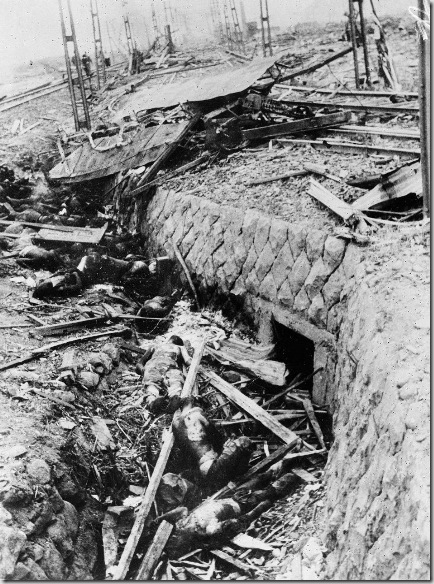
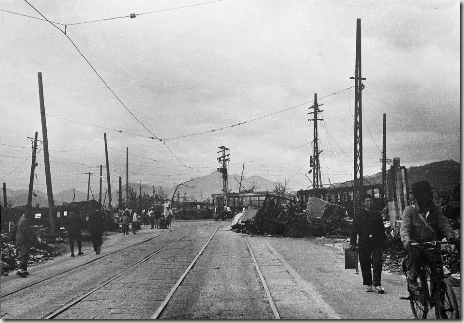


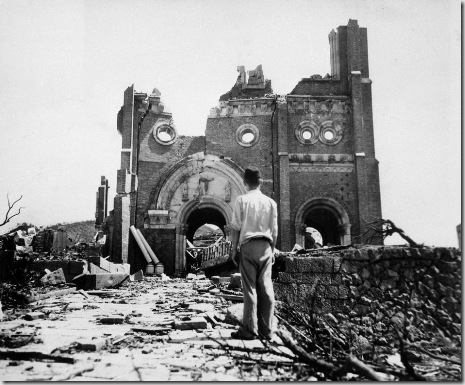
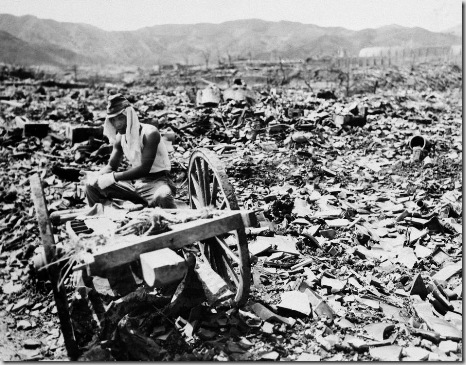




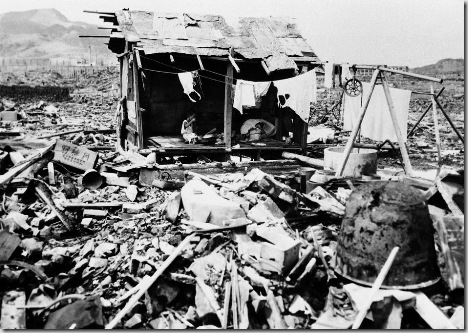
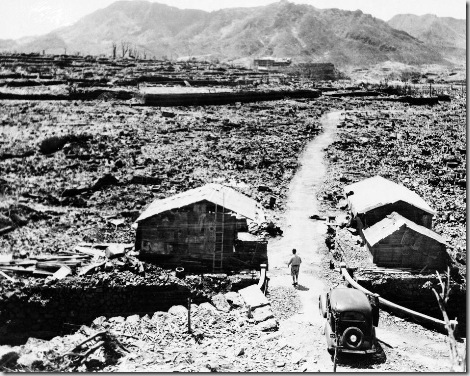

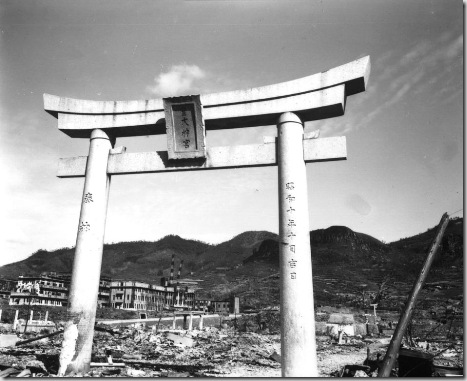








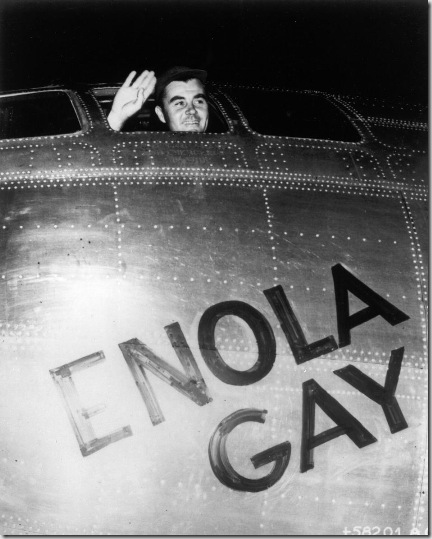
Nessun commento:
Posta un commento